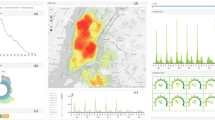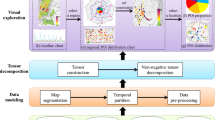Abstract
The urban transportation system is the footstone of a city’s infrastructure, and the booming bike-sharing system has become a vital part of urban transportation. Understanding the bike-sharing system and traditional taxi system as well as their similarities and differences are essential for bike-sharing rebalancing, taxi dispatching, and urban planning. However, due to the sparseness of record data and the difference in service regions, the relationship between them is indeed obscure, and previous solutions mostly focus only on a single system. In this paper, we propose a visual analytics system to investigate the similarities and differences between bike-sharing and taxi systems. The service region for each bike station is created to fuse bike-sharing data and taxi data. We harness two three-order tensors to represent them in a unified framework to generate potential patterns by tensor decomposition. The visual analytics system integrates two spatiotemporal data sources by analyzing the patterns that are typical of each data source and the patterns that are common to both data sources to assist users in better discovering the relationships between the taxi system and the bike-sharing system. We demonstrate the effectiveness of our system through real-world case studies. The urban transportation system is the footstone of a city’s infrastructure, and the booming bike-sharing system has become a vital part of urban transportation. Understanding the bike-sharing system and traditional taxi system as well as their similarities and differences are essential for bike-sharing rebalancing, taxi dispatching, and urban planning. However, due to the sparseness of record data and the difference in service regions, the relationship between them is indeed obscure, and previous solutions mostly focus only on a single system. In this paper, we propose a visual analytics system to investigate the similarities and differences between bike-sharing and taxi systems. The service region for each bike station is created to fuse bike-sharing data and taxi data. We harness two three-order tensors to represent them in a unified framework to generate potential patterns by tensor decomposition. The visual analytics system integrates two spatiotemporal data sources by analyzing the patterns that are typical of each data source and the patterns that are common to both data sources to assist users in better discovering the relationships between the taxi system and the bike-sharing system. We demonstrate the effectiveness of our system through real-world case studies.
Graphic abstract












Similar content being viewed by others
References
Andrienko N, Andrienko G, Gatalsky P (2003) Exploratory spatio-temporal visualization: an analytical review. J Vis Lang Comput 14(6):503–541
Andrienko G, Andrienko N, Fuchs G, Wood J (2017) Revealing patterns and trends of mass mobility through spatial and temporal abstraction of origin-destination movement data. IEEE Trans Vis Comput Gr 23(9):2120–2136
Cao N, Lin C, Zhu Q, Lin YR, Teng X, Wen X (2018) Voila: Visual anomaly detection and monitoring with streaming spatiotemporal data. IEEE Trans Vis Comput Gr 24(1):23–33
Carroll JD, Chang JJ (1970) Analysis of individual differences in multidimensional scaling via an n-way generalization of “eckart-young” decomposition. Psychometrika 35(3):283–319
Chen Y, Zhou XS, Huang TS (2001) One-class SVM for learning in image retrieval. In: ICIP (1), Citeseer, pp 34–37
Chen L, Jakubowicz J, Yang D, Zhang D, Pan G (2017) Fine-grained urban event detection and characterization based on tensor cofactorization. IEEE Trans Hum Mach Syst 47(3):380–391
Dai H, Tao Y, Lin H (2019) Visual analytics of urban transportation from a bike-sharing and taxi perspective. In: Proceedings of the 12th international symposium on visual information communication and interaction, VINCI’2019. Association for Computing Machinery, New York, NY, USA. https://doi.org/10.1145/3356422.3356433
De Vries T, Chawla S, Houle ME (2010) Finding local anomalies in very high dimensional space. In: 2010 IEEE international conference on data mining, IEEE, pp 128–137
Ferreira N, Poco J, Vo HT, Freire J, Silva CT (2013) Visual exploration of big spatio-temporal urban data: a study of new york city taxi trips. IEEE Trans Vis Comput Gr 19(12):2149–2158
Guo D, Chen J, MacEachren AM, Liao K (2006) A visualization system for space-time and multivariate patterns (vis-stamp). IEEE Trans Vis Comput Gr 12(6):1461–1474
Harshman RA et al (1970) Foundations of the parafac procedure: models and conditions for an “explanatory” multimodal factor analysis
Hitchcock FL (1927) The expression of a tensor or a polyadic as a sum of products. J Math Phys 6(1–4):164–189. https://doi.org/10.1002/sapm192761164
Hitchcock FL (1928) Multiple invariants and generalized rank of a p-way matrix or tensor. J Math Phys 7(1–4):39–79. https://doi.org/10.1002/sapm19287139
Ju Z, Liu H (2012) Fuzzy Gaussian mixture models. Pattern Recognit 45(3):1146–1158
Kamw F, Al-Dohuki S, Zhao Y, Eynon T, Sheets D, Yang J, Ye X, Chen W (2020) Urban structure accessibility modeling and visualization for joint spatiotemporal constraints. IEEE Trans Intell Transp Syst 21(1):104–116
Karduni A, Cho I, Wessel G, Ribarsky W, Sauda E, Dou W (2017) Urban space explorer: a visual analytics system for urban planning. IEEE Comput Gr Appl 37(5):50–60
Langran G, Chrisman NR (1988) A framework for temporal geographic information. Cartogr Int J Geogr Inf Geovis 25(3):1–14
Liu D, Xu P, Ren L (2019) Tpflow: progressive partition and multidimensional pattern extraction for large-scale spatio-temporal data analysis. IEEE Trans Vis Comput Gr 25(1):1–11
Lu M, Liang J, Wang Z, Yuan X (2016) Exploring od patterns of interested region based on taxi trajectories. J Vis 19(4):811–821
Noulas A, Scellato S, Mascolo C, Pontil M (2011) An empirical study of geographic user activity patterns in foursquare. In: Fifth international AAAI conference on weblogs and social media, pp 570–573
Papadimitriou S, Kitagawa H, Gibbons PB, Faloutsos C (2003) Loci: fast outlier detection using the local correlation integral. In: Proceedings 19th international conference on data engineering, IEEE, pp 315–326
Pei W, Wu Y, Wang S, Xiao L, Jiang H, Qayoom A (2018) Bvis: urban traffic visual analysis based on bus sparse trajectories. J Vis 21(5):873–883. https://doi.org/10.1007/s12650-018-0489-z
Peng C, Jin X, Wong KC, Shi M, Liò P (2012) Collective human mobility pattern from taxi trips in urban area. PLoS ONE 7(4):e34487
Ruiz-Tolosa JR, Castillo E (2006) From vectors to tensors. Springer, Berlin
Shi X, Lv F, Seng D, Xing B, Chen B (2019a) Visual exploration of mobility dynamics based on multi-source mobility datasets and poi information. J Vis 22(6):1209–1223
Shi X, Wang Y, Lv F, Liu W, Seng D, Lin F (2019b) Finding communities in bicycle sharing system. J Vis 22(6):1177–1192
Tucker LR (1963) Implications of factor analysis of three-way matrices for measurement of change. Probl Meas Change 15:122–137
Tucker LR (1966) Some mathematical notes on three-mode factor analysis. Psychometrika 31(3):279–311. https://doi.org/10.1007/BF02289464
Wong WK, Moore AW, Cooper GF, Wagner MM (2003) Bayesian network anomaly pattern detection for disease outbreaks. In: Proceedings of the 20th international conference on machine learning, pp 808–815
Wu W, Xu J, Zeng H, Zheng Y, Qu H, Ni B, Yuan M, Ni LM (2015) Telcovis: visual exploration of co-occurrence in urban human mobility based on telco data. IEEE Trans Vis Comput Gr 22(1):935–944
Wu W, Zheng Y, Cao N, Zeng H, Ni B, Qu H, Ni LM (2017) Mobiseg: interactive region segmentation using heterogeneous mobility data. In: 2017 IEEE Pacific visualization symposium (PacificVis), IEEE, pp 91–100
Yamanishi K, Takeuchi J, Williams G, Milne P (2004) On-line unsupervised outlier detection using finite mixtures with discounting learning algorithms. Data Min Knowl Discov 8(3):275–300. https://doi.org/10.1023/B:DAMI.0000023676.72185.7c
Yan Y, Tao Y, Xu J, Ren S, Lin H (2018) Visual analytics of bike-sharing data based on tensor factorization. J Vis 21(3):495–509
Yang D, Zhang D, Zheng VW, Yu Z (2014) Modeling user activity preference by leveraging user spatial temporal characteristics in lbsns. IEEE Trans Syst Man Cybern Syst 45(1):129–142
Zhang F, Wilkie D, Zheng Y, Xie X (2013) Sensing the pulse of urban refueling behavior. In: Proceedings of the 2013 ACM international joint conference on pervasive and ubiquitous computing, UbiComp ’13, ACM, New York, NY, USA, pp 13–22. https://doi.org/10.1145/2493432.2493448
Acknowledgements
This work was supported by the National Key Research & Development Program of China (2017YFB0202203), National Natural Science Foundation of China (61672452, 61890954, and 61972343), and NSFC-Guangdong Joint Fund (U1611263).
Author information
Authors and Affiliations
Corresponding author
Additional information
Publisher's Note
Springer Nature remains neutral with regard to jurisdictional claims in published maps and institutional affiliations.
Rights and permissions
About this article
Cite this article
Dai, H., Tao, Y. & Lin, H. Visual analytics of urban transportation from a bike-sharing and taxi perspective. J Vis 23, 1053–1070 (2020). https://doi.org/10.1007/s12650-020-00673-8
Received:
Revised:
Accepted:
Published:
Issue Date:
DOI: https://doi.org/10.1007/s12650-020-00673-8




